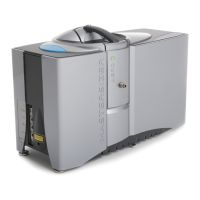Chapter 5 Viewing measurement results
Page 5-14 MAN 0474
Fundamental concepts
To understand the meaning of the results from the Mastersizer, a number of fun-
damental concepts require explanation. These are:
How the concentration is calculated.
The results are volume-based.
The result is expressed in terms of equivalent spheres.
How the distribution parameters are derived.
Calculating the Concentration (Cv)
Beer-Lambert law
The software uses the Beer-Lambert law to calculate the concentration of the sam-
ple. This may be expressed as:
Where:
I is the intensity of light at a distance b in the particle field of absorbance .
I
0
is the intensity of the light beam as it enters the particle field.
I / I
0
is the relative transmission T of the beam (measured directly by the
instrument). I
0
is the intensity of the laser beam measured at the receiver when
no sample is present and I is the intensity with sample in the beam.
Expressing the Beer-Lambert law in terms of relative transmission and re-arranging
to solve for absorbance gives:
(1)
Volume concentration
The term contains information about the concentration and size of the particles.
From scattering theory the light attenuated by a particle i may be described by:
Where:
Q
i
is the efficiency of light extinction (by scattering and absorption), calculated
from Mie theory for a particle of radius r
i
.

